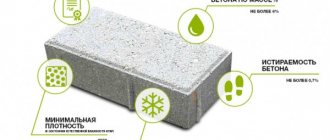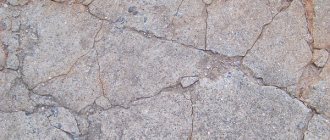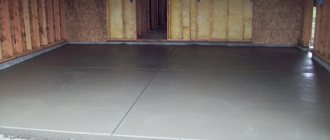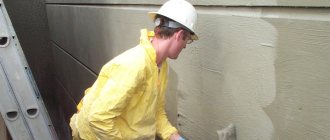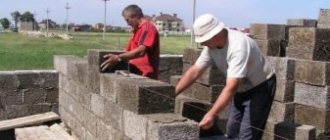When performing construction work, concrete is used, from which foundations are erected, blind areas are made and screeds are poured. An important characteristic of concrete – strength – makes it an indispensable building material. For larger volumes of work, purchased concrete is used. Not everyone knows how to make it at home. But with a limited need for concrete composition, it is easy to prepare a small amount of solution on your own after determining the optimal recipe. Correctly selected brand of cement and compliance with the proportions of concrete guarantee its quality.
Do-it-yourself concrete production
In the process of repair and construction activities carried out by experienced builders and private developers, there is often a need to use a limited volume of concrete mixture. In the current situation, it is not economically feasible to purchase a ready-made solution, since the volume of transportation costs significantly exceeds the cost of the material. The question often arises of how to make concrete yourself, ensuring the quality of the material is at factory level. Despite the apparent ease of making concrete yourself, there are a number of technological nuances.
Strength is an important characteristic of concrete
To ensure the necessary performance characteristics of ready-made concrete, it is necessary:
- use high-quality raw materials;
- adhere to technology requirements;
- use a proven recipe;
- mechanize the mixing process;
- add the desired brand of cement powder;
- pay attention to the size of sand grains;
- add the required fraction of filler to the mixture.
Independent preparation of the working mixture is not allowed for concreting critical structures - ceiling panels, supporting columns and monolithic walls. The cost of an error is too high, which can cause collapse under increased load during use. It is worth preparing concrete on your own when performing various works in the field of private housing construction - building foundations, arranging concrete footings, constructing garages and utility buildings. At the same time, issues of compliance with technology should be given priority.
You should familiarize yourself with the provisions of building codes when planning to make concrete yourself.
Preparing concrete mortar with your own hands is justified in certain situations:
- with little need for concrete mixture;
- if it is problematic to deliver concrete to the work site;
- with increased volumes of costs for purchasing the finished solution;
- if it is impossible to knead at home.
When planning to make concrete yourself, you should familiarize yourself with the provisions of building codes regulating the features of the technological process and the requirements for the building materials used.
Micro-reinforcing additives - fiber
It is used as an alternative to reinforcing mesh or as a complementary element, helping to combat the formation of microcracks in concrete. The factories produce metal, polypropylene, basalt, polyester fiber and glass fiber. Modern technologies make it possible to produce micro-reinforcing additives that can completely squeeze out traditional reinforcement methods from a number of construction and manufacturing industries. For example, you rarely see reinforced curbs, well rings, etc. anywhere.
At home, making high-quality fiber fiber from polypropylene or basalt is extremely difficult, or rather even impossible, but making metal fiber is quite possible.
What durable concrete is made from - composition and features of the components of the concrete solution
Many private owners have no doubt that they know the recipe and technology for preparing high-quality concrete. However, the first cracks that appear on the foundation or blind area after winter frosts indicate an inflated self-esteem of these “masters.” That is why it is advisable to start studying the process of preparing concrete yourself from the basics.
Composition and features of concrete mortar components
So, let's start with the components that make up the base of concrete. The concrete mixture contains the following ingredients:
- binder - Portland cement. It is manufactured at industrial enterprises that control product quality;
- filler - crushed stone or gravel, as well as sand. These materials are purchased individually and do not always meet the requirements of regulatory documentation;
- process water that does not contain foreign impurities. You should not introduce water from an unknown reservoir, the composition of which is not determined, into the concrete mixture;
- special additives. Modifiers allow you to change fluidity, provide the required plasticity, increase frost resistance and reduce setting time.
If you want to get durable concrete, you do not need to use raw materials of dubious origin, the quality of which is not confirmed by certificates of conformity. Before studying the technological features of preparing a concrete solution and becoming familiar with the recipe, we will dwell in detail on the requirements for the components included in the concrete mixture.
Cement for preparing mortar
Everyone knows that concrete is made from cement. It acts as a binding component in the concrete mixture. Mostly private developers use M400 cement or M500 cement. The strength characteristics of grade four hundred and five hundred cement make it possible to use this building material for preparing concrete in the field of housing construction. For the manufacture of building structures that can withstand increased loads, concrete is used, which contains M600 cement.
Cement acts as a binding component in the concrete mixture
When selecting Portland cement for the production of a concrete mixture, you need to pay attention to the following characteristics of the binder:
- strength properties affecting the load capacity of concrete after hardening;
- cement density, depending on the date of manufacture of the material and its storage conditions;
- the size of the powder fraction, which determines the setting time;
- corrosion resistance, important for structures located in humid environments;
- sulfate resistance, ensuring preservation of the concrete structure upon contact with salts;
- moisture resistance, which makes it difficult for moisture to penetrate deep into the concrete;
- frost resistance, which determines the possibility of using concrete under sudden temperature changes.
The introduction of modifying additives and plasticizers makes it possible to give cement the required performance properties, which significantly increases the cost of cement powder.
When purchasing Portland cement, pay attention to the following points:
It is necessary to pay attention to the strength properties of cement
- date of manufacture of the binder;
- integrity of packaging containers;
- uniformity of powder consistency;
- uniform color of cement;
- absence of foreign particles and lumps;
- availability of certificates of conformity.
The strength characteristics of a building material are measured in kg/cm2 and decrease as the cement’s shelf life expires.
Changes in strength properties occur as follows:
- during the first two months after cement production, the strength corresponds to the value declared by the manufacturer;
- after 60 days from the date of manufacture, the strength decreases by 20% of the original value;
- 6 months after packaging the cement in bags, the strength of the material does not exceed 70% of the initial one;
- within 12 months of storage, the loss of strength is half the base value.
It is not advisable to purchase caked cement, a long period of time has passed since its manufacture.
What is the best sand to use?
The correct choice of sand used as fine aggregate affects the properties of the concrete mixture.
The properties of the concrete mixture are influenced by the correct choice of sand.
When ordering sand for preparing concrete, pay attention to the quality of the material:
- sand particle size. It is 1.5-4 mm;
- absence of clay particles. The permissible clay concentration is no more than 3%;
- content of fine fractions with a size of no more than 0.6 mm, not exceeding 3%;
- bulk weight of sand, the minimum value of which is 1.4 t/m3.
The main indicators of sand quality are the minimum concentration of dust fraction and clay particles. To remove dust and clay inclusions, wash the sand under water pressure.
To prepare concrete, various types of construction sand are used:
- obtained by career means. Such material often contains an increased amount of clay and limestone particles, which negatively affects the quality of concrete. Concrete begins to collapse as the volume of clay saturated with moisture increases;
- river sand, which differs from quarry material in the absence of foreign inclusions. River sand is characterized by a homogeneous structure, providing a slight deviation in particle sizes in the overall mass of no more than 2 mm.
When choosing sand for mixing concrete, you should give preference to the more expensive alluvial material, which is superior to quarry sand in purity. It is allowed to use quarry material cleaned by the wet method.
Crushed stone or gravel - what to use as the main filler
It does not matter what material is used as coarse aggregate - gravel or crushed stone.
Crushed stone is considered the best filler for concrete mortar
Both building materials are extracted by quarrying from various types of non-metallic rocks:
- dolomite stone;
- gravel boulders;
- natural granite.
Then the extracted material is crushed using special equipment, followed by sorting into fractions. The filler size ranges from 5 to 40 mm. Medium-fraction filler with a size of 10-35 mm is most in demand. It is used for the construction of foundations.
The filler has the following performance characteristics:
- increased strength;
- frost resistance;
- homogeneous grain structure.
In terms of cost, granite crushed stone is the most expensive, while dolomite and gravel materials have an affordable price. However, they are inferior in strength to granite filler.
Filler of different fractions must be taken to compact the mixture
There are certain features of using the filler:
- dolomite crushed stone is part of lightweight concrete class B15;
- gravel material allows you to achieve the strength of concrete B25;
- The strength of concrete increased to B30 is ensured by granite filler.
You should pay attention to the level of radioactive background, which is increased in granite crushed stone. If radiation levels are increased to class II, it is not allowed to use crushed granite stone for housing construction. This material is only suitable for road construction.
Use of special additives to ensure concrete quality
To impart certain characteristics to the concrete solution, special components are introduced during mixing. Professional builders call such additives plasticizers.
They give concrete special properties:
- increase the strength characteristics of the monolith;
- ensure the workability of the concrete mixture;
- prolong the setting period of the solution;
- change the duration of the set of operational strength;
- prevent the possibility of the solution freezing at negative temperatures.
When introducing plasticizers into a concrete solution, it is important to observe the proportions.
To give concrete the necessary properties, it is important to observe the proportions when introducing plasticizers into the concrete solution.
Quality and required quantity of water
When discussing how to make a concrete solution, you should pay attention to the quality of the water added to the solution.
It, like other components, is subject to special requirements. Water should not contain:
- organic inclusions;
- animal and plant pollution;
- acidic and alkaline components.
It is not allowed to use swampy water, as well as liquids containing chemicals, oils and petroleum products. The best water option for preparing concrete is tap water. To obtain the required conditions, you should add a volume of water not exceeding a fifth of the total mass of the solution. With this moisture content in the concrete mixture, the normal course of the hydration process is ensured. The concentration of liquid in the concrete mixture affects the plasticity of the solution.
The plasticity of the solution is affected by the concentration of liquid in the concrete mixture.
Transportation Features
The most cost-effective and simplest method of transportation is transportation using a dump truck, due to the long setting time of the solution. During transportation, it is very important to ensure the correct temperature and humidity conditions to protect the concrete from excessive waterlogging or drying out. If the conditions are not met, the quality of the building material may deteriorate.
It is best to order ready-mixed concrete from manufacturers, as they maintain precise proportions of components using automatic weighing. When mixing the ingredients, special mixers are used that have a continuous or cyclic mixing action. To obtain a homogeneous mixture without delamination, concrete mixers are equipped with storage hoppers.
In what ratio are the components of the concrete mixture added?
When preparing cement mortar, the proportions must be observed in accordance with the requirements of the recipe. When calculating concrete, it is advisable to use tabular values that differ for different brands of concrete mixtures. In this case, not only the concentration of cement in the solution changes, but also the ratio of other ingredients.
For example, the mass proportions of cement, sand and crushed stone for concrete made using Portland cement M400 will be:
- 1:4.5:6.9 – for concrete mortar grade M100;
- 1:2.9:4.7 – for concrete mixture marked 200;
- 1:1.2:2.7 – for grade concrete M400.
When using Portland cement M500, the ratio of ingredients will change and be:
- 1:5.7:8.2 – for M100 concrete;
- 1:3.4:5.7 – for the composition of the M200 brand;
- 1:1.5:3.1 – for mixture M400.
Most private builders use a standard proportion of 1:3:5 for concreting at home, which involves mixing one part of Portland cement with three parts of purified sand and five parts of filler. Water is added to the mixture in the volume necessary to obtain the required consistency. Minor deviations from the specified ratio do not have a fundamental effect on the quality of the concrete solution.
In accordance with the requirements of the recipe, proportions must be observed
Significant deviations from the standard recipe negatively affect the quality of concrete:
- reduce the load capacity of the monolith after hardening;
- cause cracking of the concrete mass;
- reduce the moisture resistance of concrete due to increased porosity;
- make it difficult to carry out concrete measures due to accelerated hardening.
When planning to make a concrete mixture yourself, do not forget that changes in the properties of the raw materials also affect the quality of the finished concrete and affect the percentage. In this case, the recipe is adjusted.
Compaction factor
Like any material, lean concrete is prone to deformation. When installed correctly, it becomes strong and durable. Solutions of this type are laid using a vibrating plate or roller. This process is called compaction. It helps distribute the solution according to the chosen shape, improves the adhesion of all components and displaces unnecessary air.
The compaction coefficient of lean concrete laid according to the rules is most often 0.98-1. To improve the quality of the solution, it is necessary to use the optimal amount of water. Since the indicator of its content affects the density of the mixture.
When working in laboratories, specialists are able to correctly calculate this coefficient.
How to get a concrete solution - choose a mixing method
To independently prepare concrete mortar, various methods of mixing raw materials are used:
- manual, easy to implement and not requiring the use of special equipment. To complete the work you will need a spacious trough, as well as shovels and buckets. Manual mixing is advisable when performing a small volume of concrete work associated with pouring fence supports, constructing a blind area and other work. When mixing manually, it is problematic to ensure the homogeneity of the concrete solution. The manual mixing method is especially relevant if there is no source of electricity at the construction site;
Various methods of mixing raw materials are used for self-preparation of concrete mortar
- mechanized, providing the ability to prepare increased volumes of concrete in a limited time. For accelerated mixing, you will need a household concrete mixer. Mixing in a concrete mixer ensures increased homogeneity of the concrete mixture. Various types of gravity or forced action mixers are used. It will take no more than three minutes to prepare one portion of concrete solution. To speed up concrete work, it is advisable to place a concrete mixer directly next to the pouring area.
The choice of a specific concrete preparation method is carried out individually, depending on the planned volume of concrete work.
How to make concrete from cement - mixing the mortar manually
Home craftsmen do not always have a complete understanding of how to properly make a concrete solution when mixing it manually. Despite the apparent ease of manual mixing, there are certain nuances.
Mixing the solution manually
For manual kneading, the following stages of work must be completed:
- Prepare working tools.
- Weigh the starting materials.
- Mix the raw materials.
- Add water.
- Mix again.
Let us dwell on the features of performing individual stages.
Preparatory activities - preparing tools and raw materials
At the preparatory stage of work it is necessary to prepare:
- spacious container;
- shovels and bayonet shovels;
- buckets;
- sieve for cleaning sand.
Procedure:
- Use a sieve to remove large impurities from the sand.
- Perform calculations in the ratio of mixing buckets.
- Pour the required amount of material into the bucket.
Having prepared the dry ingredients in the required volume, proceed to the next step.
We prepare tools and raw materials
Mixing cement, sand and crushed stone fraction
A certain order must be followed when mixing ingredients:
- First you need to add Portland cement and sand.
- Then mix the cement-sand mixture until smooth.
- At the final stage, add crushed stone and mix the mixture.
To mix gradients, in addition to a bayonet shovel, an ordinary hoe is also used.
Filling with water and mixing again
Add water gradually:
- First, add a small volume of water to mix the raw materials.
- Then the remaining part is introduced and the resulting concrete is mixed again.
The prepared concrete mixture is loaded with a shovel into buckets and used for its intended purpose.
When mixing ingredients, a certain order must be followed.
Preparing concrete - how to make building material in a concrete mixer
Let's look at how to make a concrete solution that is highly homogeneous using a household concrete mixer.
Various types of units are used, differing in the principle of mixing the components:
- gravitational A special feature of this concrete mixer is a rotating container with blades and a stationary axis with a helical surface. The design allows you to change the angular position of the drum, which affects the mixing efficiency. During the mixing process on such a mixer, the concrete solution falls under its own weight;
- forced. The design of a forced-action concrete mixer includes a stationary container, inside of which a bladed working element rotates. Concrete mixture prepared in a forced mixer is more homogeneous than a mixture from a gravity mixer. Forced units are used to prepare thick mixtures containing a limited volume of water.
The concrete solution prepared in a concrete mixer is more homogeneous.
To perform the mixing you must:
- Place the concrete mixer on a level surface.
- Pour the required volume of sand and Portland cement into the drum.
- Pre-mix the components.
- Add crushed stone and water.
- Re-mix.
- Unload the ready-mixed concrete and clean the drum.
It is important to control the volume of extracted raw materials and avoid overloading the mixing device. After completion of work, the concrete mixer should be washed.
Benefits of a skinny composition
Despite the reduced strength, builders appreciated lean concrete, which has many positive aspects. Material Features:
- Simplicity of the production cycle associated with the production of lean concrete.
- Reduced production costs caused by reduced cement concentration and the use of active fillers.
- Reducing the time required for construction activities, during which there is no need to wait for the thin composition to harden.
- The ability to compact, acquiring the required strength, in the process of motion sickness using a road roller.
The main task of lean concrete is to stabilize and strengthen the soil on which the structure will be built - Increased homogeneity of the composition, the necessary strength achieved after additional compaction.
- Possibility of production directly at the construction site using production waste, secondary raw materials, and local materials as filler.
How to make high-quality concrete - recommendations from professionals
Advice from experienced builders will help you figure out how to make concrete correctly. They pay special attention to the fact that it is necessary to use high-quality crushed stone, purified sand and fresh cement. GOST for concrete regulates the requirements for raw materials and the specifics of preparing concrete mortar.
Professionals focus on the following points:
- observing the order of introducing ingredients into the mixture;
- mixing until a homogeneous consistency is achieved;
- adding mixture components in precise dosages.
To obtain a more homogeneous concrete solution, it is necessary to use a forced-action household concrete mixer. Remember that the size of the raw material also affects the quality of the concrete solution. Home craftsmen can cope with the task of independently preparing a concrete mixture. It is important to adhere to the requirements of the technological process and observe the dosage of the basic components in strict accordance with the recipe.
Scope of application
Since lean concrete has low strength, it is most often used as an auxiliary component, for example, for:
- construction of bases for road surfaces, sidewalks and other asphalt areas;
- erection of foundations;
- processing of seams of foundations;
- construction of preparation (layer up to 10 cm) for pile foundations;
- arrangement of screeds and concrete pads up to 9 cm high;
- preparation of foundations for swimming pools;
- installation of floors in the soil.
However, it is worth considering that the scope of use of lean concrete is determined by the ratio of its components.
Laying
Working with the composition is relatively simple; the builder is not required to have knowledge or skills.
Installation procedure:
You should find a place to mix the cement mortar or use a concrete mixer. Sand is poured onto the surface and cement on top. Use a shovel, trowel, rake or any convenient tool to thoroughly mix the layers. Water is added to the dry mixture and the mixture is compacted.
The process of working with lean concrete is quite simple and does not require any special skills or knowledge.
Prepare the base where concrete is planned to be laid. It is recommended to make a recess 10 cm lower than the planned burial level. This is important for the possibility of installing the reinforcement cage. If you reduce the pouring depth, you will be able to reduce the cost of solution and time.
Operating rules
Laying lean concrete will occur without problems and with high quality, if you follow the basic rules - they will help increase the durability of the structure and reduce repair costs. The standards are designed to eliminate the risk of deformation and cracking.
Basic Rules:
- At the installation stage, it is important to check and eliminate any defects from the surface.
- It is advisable to check the quality of materials in the laboratory, or at least visually evaluate the samples.
- To form a road surface, the following are always taken into account: the intensity of vehicle traffic, the type of vehicles, the strength of the main road surface, and the climatic parameters of the area. Most often, the thickness of the layer is 15 cm or less, but for routes with frequent truck traffic - 20 cm. Immediately after the road surface is laid, you can drive on it.
It is worth paying special attention to the installation of compression joints between the elements on the base and the concrete. It is better to create a distance of 15-20 cm. Cutting can be done only after the concrete has completely hardened. The depth is chosen to be about 25% of the total concrete thickness. The greatest attention should be paid to the edges; only after the compaction stage can you begin laying the main covering.
Like any other work, laying lean concrete is governed by certain rules.
The increase in the use of lean concrete occurs due to the low economic and time costs of installing lean concrete. To increase strength and resistance to destructive external influences, special additives are added to the composition, which are developed in laboratories and sold in stores.
A key way to increase strength is a vibrating roller; it compacts the concrete and increases its strength. Before vibration impacts on the coating, it is recommended to first roll over it with a roller - this will protect against damage to its integrity.

